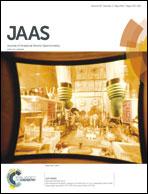Validation of classical quantitative fundamental parameters method using multivariate calibration procedures for trace element analysis in ED-XRF
Abstract
In this study, the X-ray intensities obtained from 76 soil samples were converted to concentrations by means of the Epsilon software program applying the fundamental parameters method (FP). Various National Institute of Standards and Technology (NIST) standard reference materials (SRMs) were used to evaluate the accuracy of the analysis. The discussion was restricted to the analysis of only ten elements. The results have indicated that the soil samples contain V (10–93), Mn (313–7227), Co (3–18), Ni (47–281), Cu (1–32), Zn (20–86), As (30–236), Sr (131–592), Ba (78–7329), Rb (25–149) and Pb (17–67) between minimum and maximum values in a range of mg kg−1. Partial Least Squares (PLS) and Principle Component Regression (PCR) models were used to predict the elemental concentrations. Cross-validation (CV) was used to calculate the Estimated Mean Square Predictive Error (EMSPE) values and to determine the optimal number of PLS and PCR components. Predicted concentrations were based on EMSPE values, utilizing 1 PLS and PCR components for V, Co, Cu, Zn, 3 PLS and PCR components for Mn, Ni, Pb, 5 PLS and 8 PCR components for As and Ba, 7 PLS and 10 PCR components for Rb and 3 PLS and 4 PCR components for Sr with minimum EMSPE values. It was observed that prediction errors and increasing factor numbers depend on the reference material concentration intervals as much as the number of SRMs. On the other hand, when PLS and PCR models were compared between themselves, it was seen that the PLS model had a strong relation to the FP method as compared to PCR model, with less prediction errors and component numbers.


 Please wait while we load your content...
Please wait while we load your content...